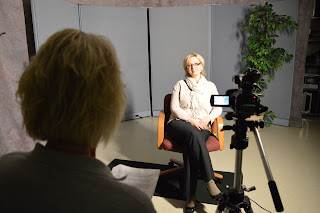As I write this article on a snowy Tuesday morning, a high
school student is working on his History Day project in the PLAEA video suite. One element of his project will be an
interview with a patent attorney, so he and I have been discussing how to conduct
a successful interview.
When shooting an
interview to be part of a video project, you have to visualize how it fits in
the entire project. Rarely is the entire
interview shown in one continuous segment.
Rather, the interview is cut into smaller segments, often called “sound
bites”.
Before the Interview
Select a quiet
location for the interview. Turn off the
radio, close the door to block out external noise, do what it takes to
eliminate unwanted sounds.
Write open-ended questions.
Avoid asking “yes or no” questions; try to ask questions that will draw
out the person being interviewed.
If possible, share the interview questions with your
intended subject beforehand. That gives
them an opportunity to formulate their replies.
Explain to your subject how you plan to interview them. Ask that they give you a second or two of
silence after you ask a question and before they reply. That gives the editor a quiet spot to begin
the video clip.
Ask the subject to restate the question or include it in their
answer. In most instances, the question
asked is not used in the final version of a video project, so the subject’s
answer needs to stand alone. If you
asked the subject what it was like the first time she went skydiving, she might
answer, “It was fantastic!” But that
sound bite would work better if the answer was, “The first time I went
skydiving was fantastic!”
During the Interview
 You should sit near the camera, just off to one side. Ask
your subject to ignore the camera and look at you as the interview
proceeds.
You should sit near the camera, just off to one side. Ask
your subject to ignore the camera and look at you as the interview
proceeds.
Make your subject feel comfortable. Having that one-eyed camera lens pointing at
you can be unnerving, to say the least.
Explain to your interview subject that you two are just going to chat
for a few minutes. If anyone makes a
mistake, you will just go back and answer that question again. “So relax and let’s have a good time while we
talk.”
With the camera recording, have your subject say and spell
their name and job title (if needed for the project). This video clip won’t be used in your project
but it is an excellent way to immediately identify the person in the clip as
you work on your editing.
Ask a question and then be quiet while your subject
answers. Give encouragement in the form
of non-verbal feedback. Smiles and nods
of encouragement from you are fine, but the audience doesn’t need to year you
saying, “Uh-huh” in the background.
If your subject’s answer is too long, ask them to re-phrase
it and answer it again. Your goal here
is to keep the sound bites short.
Listen to the answers and be prepared to ask follow-up
questions. Years ago, I was the camera
operator for an educator who was interviewing a stunt woman. The stunt woman answered a question about a
movie she worked on and finished her answer with, “And that was the time I
broke my back during filming.” The
interviewer nodded and then asked the next pre-written question. It would have been better for the interviewer
to ask a follow-up question like, “You broke your back? Tell me more about that.”
Ask what you didn’t
ask. Most times, the person being
interviewed has a story or anecdote they are just dying to share. All they need is for you to ask the right
question. So at the end of your
interview, ask them what you didn’t ask.
Your question could be, “What else would you like to share?” Or perhaps, “What is the one thing you are
dying to tell me about today?” Or even, “What did I forget to ask you?”
As is the case in
all video production, the secret to success is in planning before you
shoot. So plan ahead, write open-ended
questions and make the actual interview a fun and positive experience for
everyone.

No comments:
Post a Comment